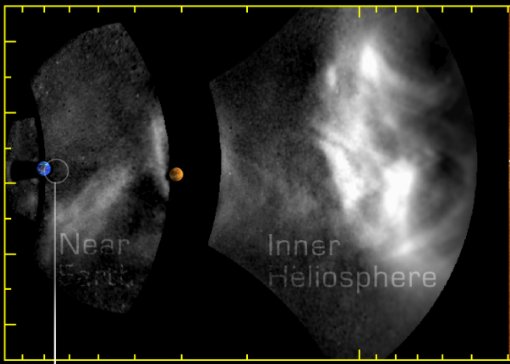
|
STEREO: Exploring Solar Storms |
||||||||
|
|||||||||
 |

Mathematics Skill or Topic Area:
Rational Number Operations
Next Gen Science Standards ESS1: Earth’s Place in the Universe; ETS2: Links Among Engineering, Technology, Science, and Society
Common Core ELA for Science: RST.6-8.2. Determine the central ideas or conclusions of a text; provide an accurate summary of the text distinct from prior knowledge or opinions. RST.6-8.8. Distinguish among facts, reasoned judgment based on research findings, and speculation in a text. RST.6-8.9. Compare and contrast the information gained from experiments, simulations, video, or multimedia sources with that gained from reading a text on the same topic.
Common Core Math Standard: CC.8.NS.1: Know that numbers that are not rational are called irrational. Understand informally that every number has a decimal expansion; for rational numbers show that the decimal expansion repeats eventually, and convert a decimal expansion which repeats eventually into a rational number.

Video Engagement: Satellites and Solar Eruptions Learn about twin satellites NASA launched to collect data about the sun and find out why we study the sun and what scientists learn from these missions (5 minutes). View Program
|
Engage your students with a press release: Space Storm Tracked from Sun to Earth
CMEs, or Coronal Mass Ejections, are billion-ton clouds of solar plasma launched by the same explosions that spark solar flares. When they sweep past
our planet at millions of miles per hour, they can cause auroras, radiation storms, and in extreme cases power outages. Tracking these clouds and predicting
their arrival is an important part of space weather forecasting.
For the first time, spacecraft far from Earth have watched a solar storm engulf our planet.
The image above shows the location of Earth (blue ball) and Venus (gold ball), and the position and size of the CME between them,
and about to arrive at Earth.The sun is located just beyond the far right edge of the image.
"The movie sent chills down my spine," says Craig DeForest of the Southwest Research Institute in Boulder, Colorado.
"It shows a CME swelling into an enormous wall of plasma and then washing over the tiny blue speck of Earth where we live. I felt very small."
STEREO-A is one of two spacecraft launched in 2006 to observe solar activity from widely-spaced locations along Earth's orbit. At the time of
the storm, STEREO-A was more than 65 million miles from Earth, giving it the "big picture" view other spacecraft in Earth orbit lack.
When CMEs first leave the sun, they are bright and easy to see. Visibility is quickly reduced, however, as the clouds expand
into the void. By the time a typical CME crosses the orbit of Venus, it is a billion times fainter than the surface of the full
Moon, and more than a thousand times fainter than the Milky Way. CMEs that reach Earth are almost as gossamer as vacuum itself
and correspondingly transparent.
Alysha Reinard of NOAA's Space Weather Prediction Center explains the benefits for space weather forecasting:
"Until quite recently, spacecraft could see CMEs only when they were still quite close to the sun. By calculating a CME's speed
during this brief period, we were able to estimate when it would reach Earth. After the first few hours, however, the CME would
leave this field of view and after that we were 'in the dark' about its progress."
The new movies produced by the twin STEREO spacecraft now pinpoint not only the arrival time of the CME, but also its mass.
When the CME first left the sun, it was cavernous,
with walls of magnetism encircling a cloud of low-density gas. As the CME crossed the Sun-Earth divide, however, its shape changed.
The CME "snow-plowed" through the solar wind, scooping up material to form a towering wall of plasma. By the time the CME reached Earth,
its forward wall was sagging inward under the weight of accumulated gas.
Press release date line - August 18, 2011 Press release
location: [
Click Here ] |
|
Explore math connections with SpaceMath@NASA
Problem I -
CMEs and Rational Numbers -
Between 1996 and 2006, astronomers detected 11,000 CME events. If 600 of these CMEs were directed towards Earth, write the
simplified fraction that expresses how many of the total CMEs from the sun were directed towards Earth.
[Answer: 600/11000 simplifies to 6/110 and then to the final answer of 3/55]
Problem II -
Exploring Solar Storms. -
During the last sunspot cycle from 1996 to 2008 there were 600 CMEs directed towards Earth. 1/6 of these CMEs occurred at the same time as
major X-class solar flares that disrupted radio communication on Earth.
If 1/5 of the X-class flares also produced major radiation storms that affected satellites in space, how many of the CMEs produced major radiation storms?
[Answer: 600 x 1/6 x 1/5 = 20 CMEs]
Problem III -
CME Travel Times-
A CME left the sun and was observed by the STEREO satellites as it traveled towards Earth. It passed Mercury in 19 hours and Venus after another 30 hours had passed. If Venus is located 7/10 of
the distance between Earth and the Sun, after how many elapsed hours will the CME reach Earth? [Answer: Use the information above to draw a diagram of the orbits before you attempt to work this problem. The total elapsed time to get to Venus was 49 hours. During this
time it traveled 7/10 of the distance to Earth. So, to reach Earth, we must solve the equation 7/10 T = 49 hours and so T = 70 hours.]
Explain
your thinking: Write
your own problem - Using information
found in the Math Connection problems, the press release or the video
program, create your own math problem. Explain why you set the problem up this
way, and how you might find its answer.
Evaluate
your understanding: Challenge Problem: Tracking a Major CME to Earth
-
On March 8, 2012 a major CME left the sun. Mercury is 1/3 the distance between Earth and the Sun and the CME passed the orbit of Mercury in 16 hours.
If Venus is located 7/10 of the distance between Earth and the Sun, how long did the CME take to travel between Venus and Earth?
[Answer: Use the information above to draw a diagram of the orbits before you attempt to work this problem. The distance from Venus to Earth is 3/10 the Earth-Sun distance.
The CME took 16 hours to travel 1/3 the Earth-Sun distance. Solving the proportion: 16/(1/3) = X/(3/10) so 48 = 10x/3. Then
X = 144/10. So it will take 14.4 hours to travel from Venus to Earth.

NASA / JPL
3-D Solar System
Extend your new knowledge - The two STEREO spacecraft take pictures of the sun from two different vantage points along Earth's orbit. In this exercise, students use the EOSS simulator and explore the location and movement of the twin STEREO spacecraft while working with fractions and mixed numbers. [ Open PDF ]